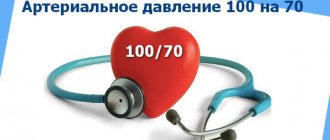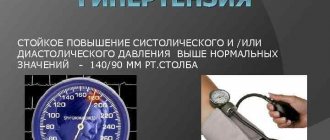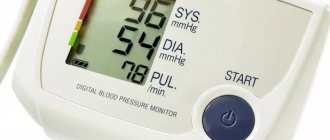A pressure of 130 over 60 is not normal; in most clinical cases, it signals a dysregulation of the cardiovascular system. When measuring blood pressure, people are guided by systolic pressure values, however, for an accurate assessment it is necessary to take into account the data of the lower indicator. To get a complete picture, experts recommend calculating the difference between the upper and lower values, which in this case exceeds the norm. What reasons contribute to deviations from normal tonometer values and how to diagnose them in a timely manner?
What is pressure
This indicator can provide information about the level of oxygen supply to organ cells in the human body. Depending on age and the presence of diseases, data may change throughout the day. There are two types of values - systolic and diastolic. Systolic is the moment of blood pressure in the arteries during the contraction of the heart, and diastole is measured at the moment of its relaxation.
When measured with a tonometer, the upper (systolic) pressure is always greater than the diastolic pressure. Systole is the very moment of contraction of the heart muscle. This indicator is measured in millimeters of mercury. Any significant jumps in values should be alarming, because both a decrease and an increase in indicators:
- have a detrimental effect on blood vessels and the condition of all organs;
- contribute to accelerated aging of the body.
Symptoms
Poor health and rapid loss of strength indicate problems in the body.
The pathological clinical picture with arterial values of 130/60 is manifested by various symptoms, such as:
- nausea;
- chills;
- weakness;
- migraine;
- slow pulse;
- fatigue;
- lack of air;
- neurosis;
- heart pressure;
- mood swings;
- fast fatiguability;
- anxiety;
- dizziness;
- prostration;
- depression;
- sweating;
- accelerated pulse;
- constant malaise;
- loss of consciousness;
- irritability.
What pressure is considered normal?
In a healthy person, the systolic reading should not exceed 130 mmHg, and diastole should not exceed 90 mmHg. Normal pulse is from 70 to 85 depending on age: the older the patient, the higher the pulse. If a patient has constantly elevated levels, this indicates the presence of arterial hypertension (hypertension); at an early stage, the disease can be eliminated with proper treatment and undergoing various procedures. Low lower pressure is not normal, so it must be determined and the cause found.
Under the influence of various factors, indicators change throughout the day. For example, at rest the numbers may drop to normal; after vigorous exercise, the heart pumps more blood and they increase. The measurement process is carried out strictly at rest. Even the time of day can affect the value. Most measurements are taken in the middle of the day.
Signs of development of the condition
Regardless of the reason that provoked the high pulse difference, the main symptoms characteristic of the pathology are identified:
- Headache.
- Increased fatigue.
- Sleep disorder.
- Pain in the heart area.
- Interruptions in the functioning of the heart.
- Excessive irritability.
- Feeling of increasing anxiety.
Dizziness occurs due to hypoxia, when organs and tissues receive insufficient nutrients and oxygen
Symptoms of hyperthyroidism
In most cases, dissonance between blood pressure indicators is detected in hyperthyroidism.
Impaired production of thyroid hormones can be determined by the following signs:
- Rapid pulse.
- Heavy sweating.
- Nausea, pain in the abdominal cavity.
- Excessive feeling of hunger;
- Irritability, anxiety.
- Disruptions in the menstrual cycle.
- Decreased libido in men.
Symptoms of heart pathologies
Heart rhythm disturbances and valve defects are accompanied by typical symptoms of heart failure:
- Pain in the chest area.
- Increasing shortness of breath.
- Increased heart rate.
- Irrhythmic pulse.
The pain syndrome is stabbing in nature, which intensifies when inhaling or after eating.
Manifestations of atherosclerosis
The atherosclerotic process is the main cause of loss of vascular elasticity, resulting in impaired blood circulation. A high pulse difference against the background of atherosclerosis can be provoked by a disorder of the thyroid gland, diabetes mellitus.
With atherosclerotic vascular damage from cholesterol plaques in patients, pressure values can vary throughout the day and reach parameters of 135 to 65 or 128/60 mm Hg. Art. The pathology is characterized by the following manifestations:
- Weakening of brain functions.
- Mental and emotional disorders.
- Sleep disorder.
- Noise in ears.
- Dizziness.
- Periodic numbness of the limbs.
Important! As a rule, dissonance between indicators occurs against the background of diseases associated with disturbances of heart rhythm and arterial tone in people over 35 years of age. However, this disorder can be diagnosed in a child, as well as in a teenager, during the period of hormonal changes in the body.
What does pressure 130 over 60 mean?
In this case, the alarming factor is diastole, because by lowering it, you can further reduce the systolic value. Normally, the second number should be from 70 to 90. A lower pressure of 60 may be normal for people actively involved in sports, and also if there are no alarming symptoms. Deterioration in well-being will help identify the progression of the disease. If there are significant problems:
- dizziness;
- increased sweating;
- nausea, vomiting;
- severe weakness.
In addition, it is worth paying attention to the upper indicator - systolic pressure, which is equal to 130 mmHg. The normal value is 120 mmHg, no less and no more. In this case, the indicator is increased by 10 units. Often this result is a consequence of incorrect blood pressure measurement, for example:
- earlier than 30 minutes after smoking;
- with a full bladder;
- immediately after active physical activity.
Diagnostics
Any disease can be diagnosed only after a thorough examination. First of all, you need to measure your blood pressure for a day or more. For this you will need a tonometer. Today, many models with electronic devices are sold, so everyone can use such devices. The main thing is to comply with the rules and requirements:
- You cannot drink strong tea, coffee, tonic drinks, or alcohol 30 minutes before measurements. You should also stop smoking.
- It is advisable to go to the toilet before measuring so that the bladder does not put pressure.
- The person’s condition should be calm and balanced.
- It is better to relax by listening to pleasant soothing music.
- You should not talk or move during the procedure.
- The position should be comfortable and comfortable.
- Measure blood pressure on both arms.
If the result seems unreliable to you, take another measurement after about half an hour.
At the clinic, the doctor will prescribe a cardiogram and weekly blood pressure monitoring. You will have to measure blood pressure several times a day: at rest, after physical activity.
To find out the cause of the abnormal pressure, the cardiologist refers the patient to ultrasound, aortography, magnetic resonance imaging, etc. In many cases, blood and urine tests must be taken. Sometimes you have to visit other specialists - a nephrologist, endocrinologist, etc.
Causes
In order to start solving health problems in a timely manner, you need to know what low lower blood pressure means in a person. The source of such symptoms are various pathological conditions of the cardiovascular system. Common reasons:
- congenital narrowing (coarctation) of the aorta;
- post-infarction atherosclerosis;
- open aortic duct;
- pathologies of arteries, veins and blood vessels;
- aortic valve insufficiency;
- vegetative-vascular dystonia;
- pathologies of the endocrine system.
In some cases, a result of 130 to 60 may indicate pathologies with the kidneys. Vegetative-vascular dystonia provokes a decrease in values only during an exacerbation, which is accompanied by headaches, nausea and other symptoms. Pathologies of the endocrine system also lower the diastolic reading due to excessive production of certain hormones, and pressure of 130 to 60 is the result of thyrotoxicosis, hyperfunction of the endocrine gland.
Changes in pulse pressure during pregnancy
During pregnancy, there is an increase in circulating blood, so a slight increase in tonometer values is normal for a woman. However, a decrease in diastolic indicator is not normal, since it indicates the development of abnormalities.
This condition provokes hypoxia, when oxygen deficiency affects not only the fetus’s body, but also the woman herself. The disorder is manifested by a decrease in the functional activity of the brain, myocardium, and kidneys. In the later stages, gestosis may develop, in which blood pressure rises sharply.
In the early stages, a high difference between the values leads to severe toxicosis, which affects the development of the fetus. Women may experience weakness in labor, affecting the intensity of uterine contractions.
The dangers of low diastolic pressure
The pathological condition of the cardiovascular system can be fraught with serious consequences. Among them:
- disturbance of vascular tone;
- high risk of serious cardiovascular diseases;
- risk of coronary heart disease;
- in older people - senile dementia, Alzheimer's disease;
- deterioration of kidney and liver function;
- depressive states;
- diseases of the central nervous system.
It is especially dangerous if diastolic pressure is low in pregnant women. In this case, this is a sign of poor blood supply to the fetus, which can cause oxygen starvation of the fetus (hypoxia), the development of numerous congenital malformations, and placental insufficiency. To avoid such problems, it is recommended to regularly check your blood pressure readings. A result of 130 to 60 is also not the norm for pregnant women.
- Couscous - what is it, recipes with photos. Benefits of couscous
- Why do girls and women menstruate twice a month? Reasons for repeated discharge
- The meaning of moles in men and women is the secret meaning of the marks. What do birthmarks on the human body mean?
How to raise lower blood pressure
With pathologically low blood pressure levels, it is possible to increase it. The main thing is to remember that this will only help remove the symptoms; a permanently reduced result requires careful diagnosis. There are also cases when doctors do not recommend increasing the value of 130 to 60. For example, in old age, especially if there are no symptoms. It is imperative that the issue of increasing blood pressure be approached carefully so as not to overestimate the systolic reading.
If there are no contraindications, you need to know how to raise diastolic pressure correctly. You can resort to effective drug therapy, but this method should be chosen only as prescribed by a doctor: many drugs have negative effects on the kidneys and liver. For young people, you can raise your blood pressure with low-intensity exercise or caffeine if your blood pressure rarely rises. You cannot overdo it - if you need to increase it regularly, you need to contact a specialist.
How to raise lower blood pressure at home
In addition to drug therapy, there are many ways to help increase diastolic blood pressure. For example, there is a folk recipe - a composition that is easy to prepare at home. It will require the following components:
- dried cornflower flowers;
- Leuzea;
- motherwort;
- liquorice root;
- dry bearberry.
There is only one contraindication for such a recipe – individual intolerance. Preparation:
- Take 1 tablespoon of all dry ingredients;
- pour 1 liter of boiling water over everything;
- let it brew for a day;
- strain and take one tablespoon 1-2 times a day or as indicated.
Prevention
In order to prevent a decrease in readings to 130 to 60, you should know why the lower pressure is low. It is worth adhering to important rules that bring blood pressure back to normal:
- you need to do enough physical exercise;
- proper sleep mode, healthy sleep should last at least 8 hours;
- every day food should contain walnuts, buckwheat, grapes, fresh herbs so that a person receives all the necessary vitamins and nutrients;
- The diet should be correct and measured, eating should be no later than 3-4 hours before bedtime.
You can overcome high or low blood pressure at the very beginning of the development of pathology. When a problem with blood pressure begins, you definitely need to pay attention to your daily routine and the amount of physical activity, the lack of which can cause pathologies of the heart and blood vessels. The heart must always work actively so that the blood vessels do not lose their tone. For men and women, the recommendations do not change; blood circulation in the body is normalized through an active lifestyle and proper nutrition.
Secondary causes of decreased diastolic blood pressure
A pressure of 130/60 is also observed with secondary changes caused by diseases of the heart and blood vessels:
- mitral valve insufficiency,
- severe form of anemia,
- thyrotoxicosis,
- arteriovenous fistulas,
- renal failure,
- aortitis rheumatoid and other origins,
- coarctation of the aorta,
- Congenital heart defect,
- bacterial endocarditis affects not only the inner wall of the heart, but also the valves, which leads to the formation of aortic valve disease,
- aortic aneurysm,
- vegetative-vascular dystonia.
The causes of low diastolic pressure vary in origin and timing. Rheumatism usually begins in young years, but signs of heart disease appear many years later.
Aortic insufficiency or stenosis
The main culprit for the decrease in diastolic pressure is a consequence of rheumatism - aortic disease. Most people associate rheumatism with joint pain. In reality, this disease “licks the joints and bites the heart.” In other words, with rheumatism, it is not so much the legs that suffer, but the heart valves. For the most part, mitral valve disease develops.
Aortic insufficiency and aortic stenosis often develop, which are combined in 50% of cases. The bottom line is that during diastole the aortic valve is not able to close completely. As a result, some of the blood rushes back into the left ventricle (regurgitation). Over time, it is forced to increase the mass in order to push the excess volume of blood into the aorta.
Important! While the heart is overloaded, the peripheral arteries are unable to fill with blood due to backflow. As a result, their pressure decreases.
This problem goes unnoticed for many years because the heart adapts to the stress by increasing the frequency or strength of the heart muscle. But sooner or later, compensatory possibilities dry up.
Early signs of the defect appear - a feeling of pulsation throughout the body. A person can count the pulse without feeling on the wrist - just by looking at the watch. Then attacks of tachycardia, chest pain and a decrease in diastolic pressure begin, sometimes it is difficult to determine. At the same time, systolic pressure increases.
Drug therapy does not bring relief. The way out is aortic valve replacement.
Aortitis
The cause of inflammation of the aorta is various diseases - syphilis, tuberculosis or streptococcal infection. They lead to expansion of the aorta. With inflammation of the thoracic region, pain appears at the level of the heart with irradiation to the shoulder blades, neck, and back of the head. Unlike angina, they are not relieved by nitroglycerin.
If the abdominal part of the aorta becomes inflamed, pain in the abdomen and lower back periodically occurs. In addition, patients experience fainting, dizziness, and increased body temperature.
Non-infectious aortitis occurs in allergic vasculitis and autoimmune diseases. The so-called juvenile aortitis develops in young girls.
The disease develops with collagenosis, spondyloarthritis, rheumatism, thromboangiitis obliterans. Diagnosis of aortitis is carried out by doctors of various profiles - phthisiatricians, rheumatologists, pulmonologists, traumatologists.
By the way! The main symptom of aortitis is an asymmetrical pulse in the arms. It may disappear on one side, while systolic pressure increases and diastolic pressure decreases.
Anemia
People suffering from low blood pressure are often diagnosed with anemia. The most common causes of the disease are deficiency of iron, folic acid and vitamin B1.
Diseases differ in origin:
- Posthemorrhagic anemia occurs when there is heavy loss during menstruation, gastric bleeding or cancer.
- Hemolytic anemia develops due to increased destruction of red blood cells.
- A group of diseases caused by insufficient formation of blood elements - iron, vitamin B 12, B 1, folic acid.
With chronic anemia, there is a decrease in both pressure indicators, as well as numbness in the arms and legs. The number of red blood cells in the blood is reduced, and hemoglobin is reduced. General signs of the disease are observed - hair loss, brittle nails.
Arteriovenous fistulas
Congenital arteriovenous fistulas are formed as a result of the preservation of embryonic vessels that have not turned into arteries and veins. Acquired communications between these vessels occur in the following cases:
- after penetrating wounds or blunt trauma,
- skin fistulas with dermatitis,
- cirrhosis of the liver,
- Paget's disease.
Pathological anastomosis between arteries and veins lead to premature discharge of arterial blood into the venous system. Fluid enters the veins under pressure, which means it causes them to expand and swell. On the part of the heart, pressure surges are observed.










